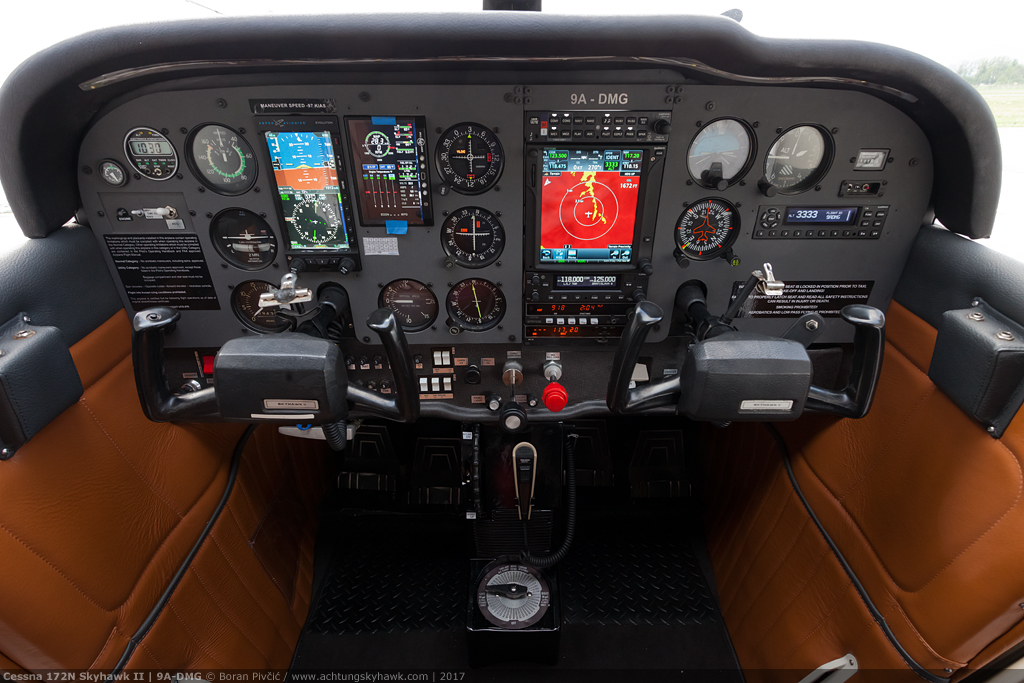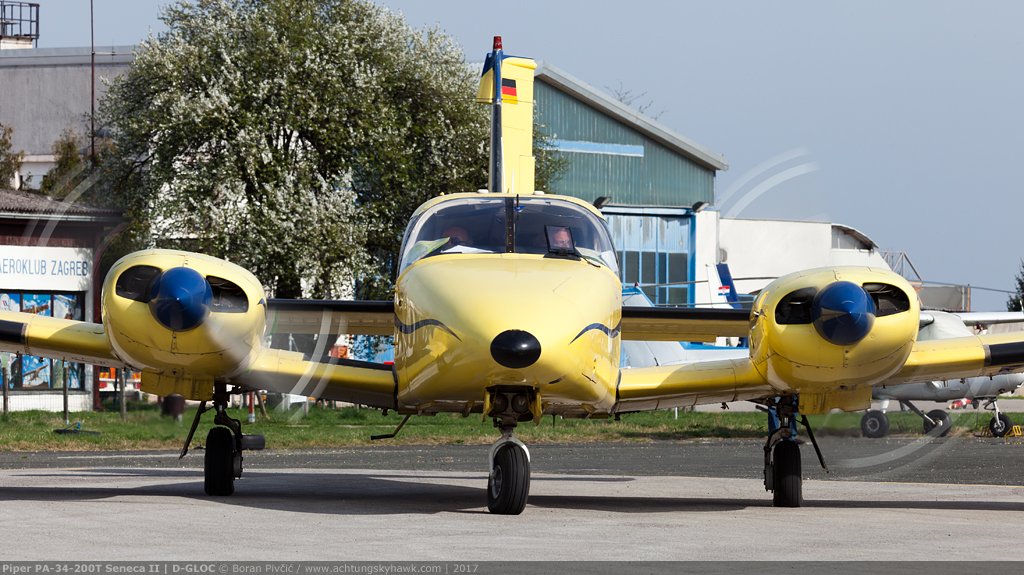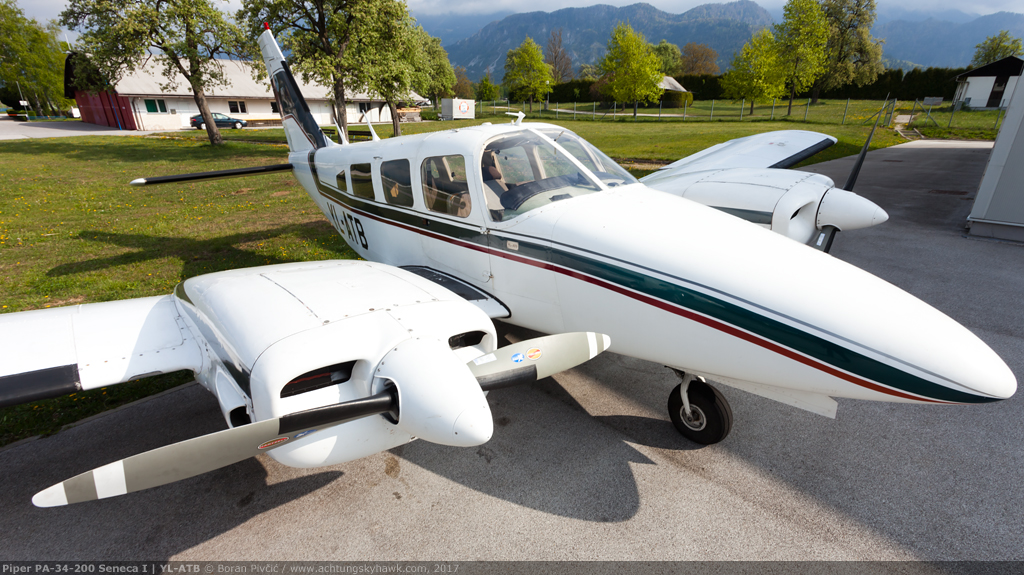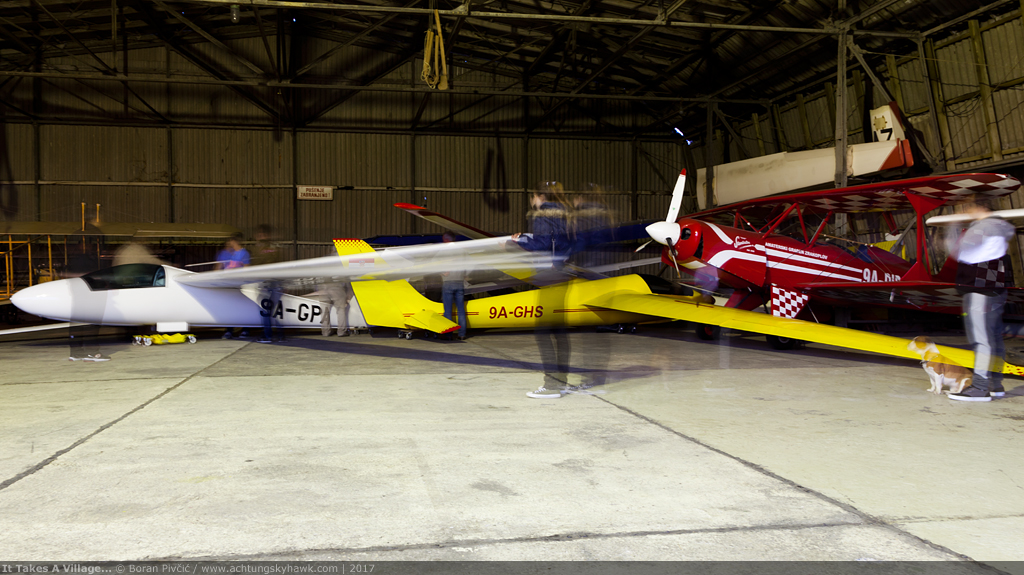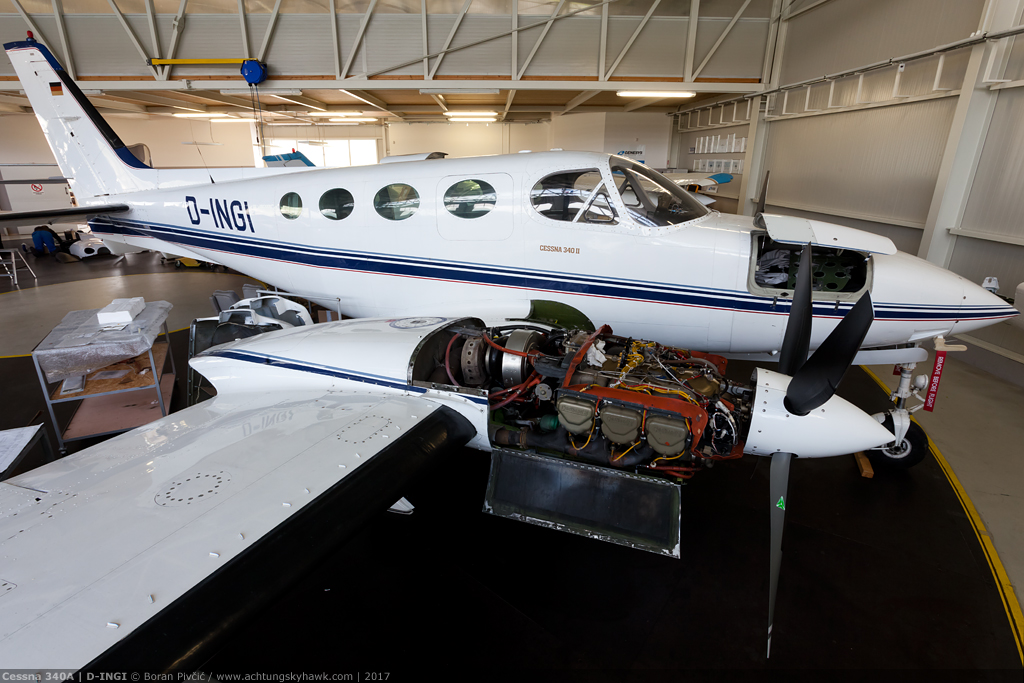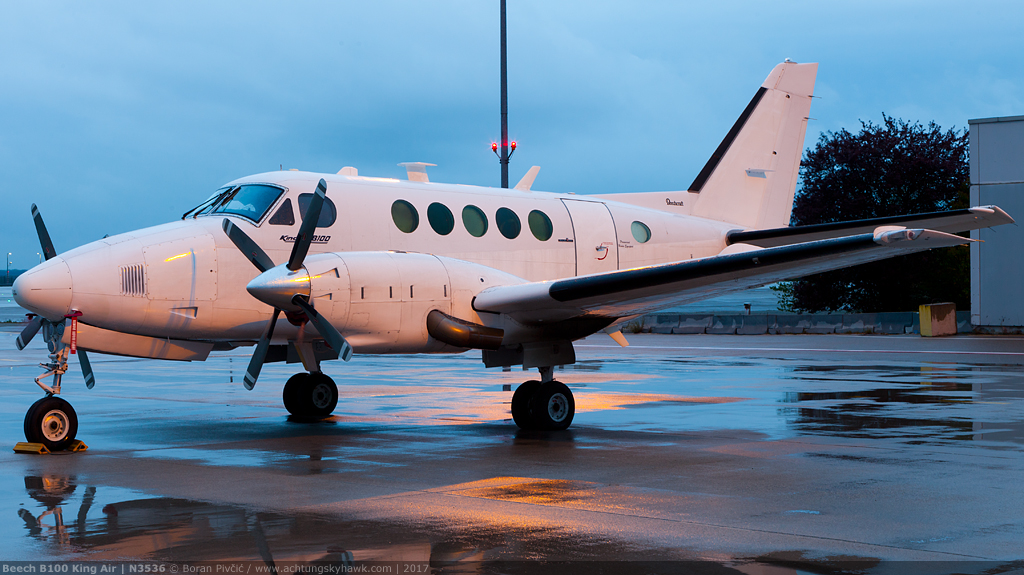By me
All photos me too, copyrighted
In a return to form for a website I claimed would deal with “news from Croatian general aviation” – but which most of the time does nothing of the sort – my second piece for October 2020 could not be more on point: a photo session with the newest addition to the Croatian civil registry, Piper Seneca 9A-LEM. And while Senecas as such hardly qualify for the Endangered Airplane List, this particular example is a nowadays very rare first generation model – and only the second such example I’ve come across IRL. Now, if that wasn’t enough to reach for my car keys… 😀

It may not be the most exciting shape out there… but there are enough nerdy bits on it to keep me occupied for hours!
Swiss stability
Like with Soviet aircraft – whose designations and serial numbers amount to pretty much the airframe’s entire ID card – you can tell a lot about pre-80s Pipers just by making sense of all the gibberish on their data plates. 9A-LEM’s, for example, reads PA-34-200 with the serial 34–7350327, which translates to:
- 34 – the type designation for the Seneca family
- 73 – produced in 1973
- 50 – model code for the original Seneca series* (the Seneca II would be designated 70, while early Seneca IIIs – the last to use the system – were 33s)
- 327 – the 327th aircraft produced in 1973 (but not the 327th Seneca overall; with 360 produced in 1972, LEM would be no. 687, excluding the prototype)
The 200 suffix is a nugget as well, since it indicates that this model is powered by normally aspirated, fuel injected, four cylinder Lycoming L/IO-3601 engines producing 200 HP – making it the only Seneca mark not to use turbocharging. Its occasionally marginal performance at altitude (particularly in the climb) meant it would soon give way to the PA-34-200T Seneca II, powered by six cylinder Continental L/TSIO-360 engines developing the same 200 HP – but now equipped with turbochargers that could maintain that output all the way to 12,000 ft. Though this did wonders for overall performance, the subsequent PA-34-220T Seneca III would up the take off power to 220 HP in order to cope with the type’s constant mass increases (max continuous remained at 200), a solution that would also be re-used for the Seneca IV – before finally being upgraded to 220 HP both for take off an continuously on today’s Seneca V (achieved by fitting a different engine variant and improved turbocharger w/ intercooler).
* while it does appear in a number of sources on the Internet, the first Seneca series was never formally called the Seneca I; only the four later generations had a Roman numeral to their name

The first of the original Seneca’s several dead giveaways are the boxy engine nacelles – all lumps, bumps and intakes – and the 1.93 meter two-blade, constant speed, fully feathering prop. The type’s familiar three-blade unit of the same span would appear only in 1979 on the Seneca III – and even then initially as just an optional extra
For a light aircraft that’s pushing half a decade in service – and which you would expect has seen its fair share of commercial operators and flight schools – LEM had led an unusually quiet life, having only ever had two previous identities: N56394 for delivery, and HB-LEM from September 1973 to February 2020. Interestingly, its time in Switzerland – among some pretty high terrain – was spent accident-free and in the hands of just one private owner, having never seen a single student or contract pilot in the nearly 5,800 flight hours it had logged over there. In fact, the only blot on its record that I could find is an airprox incident in 2018 that ended without damage.
Proving that you can’t run away from school forever, this would change on 28 February when HB-LEM landed at Pisarovina-Bratina Airfield (LDZR), a private airstrip near Zagreb owned by local flight training provider Pan Avia. Through a combination of maintenance, paperwork and just plain old corona crisis, it would take nearly seven months for it to join the active fleet, by which time it would become known as 9A-LEM. Unsurprisingly, it will be used by future airliner drivers for their Multi Engine Piston (MEP) training, a task for which many operators said it was well suited, despite its asthmatic climb performance on one engine (somewhere around the 400 FPM mark in a typical training configuration, less – but only just – than the purpose-built PA-44 Seminole trainer).
American recycling
Having established that LEM’s history is squeaky clean and disappointingly straightforward, it’s time to get down to best part: the nerdy details! Even though the Seneca had looked thoroughly modern and quite cool when it went on sale in 1972 (particularly in comparison with Piper’s other twins, the 50s PA-23 Aztec and 60s PA-30/39 Twin Comanche), the truth of the matter is that it was still very much a “real Piper”: essentially designed on the back of common off-the-shelf components and structural bits & bobs of the company’s other aircraft. Indeed, the main parts donor – contributing the fuselage, wing, tail, interior and cockpit – was the six seat PA-32 Cherokee Six, traces of which would remain easily identifiable (as will become obvious later!) well until the early 80s Seneca III.

The first of the many telltale signs of the Seneca’s Cherokee Six DNA are the square windows, copied over bolt-for-bolt. With the coming of the Seneca II, they would receive rounded edges – and then be fully recontoured and resized on the Seneca IV (the III would introduce a third set in the cargo bay)
And while you’d be hard pressed to find a manufacturer that did not dip into its own parts bin for every new design, Piper is widely acknowledged for elevating this “Lego approach” to wholly new levels. By keeping things simple and not trying to reinvent the wheel – except in rare moments of madness such as the PA-31P Pressurized Navajo or the PA-35 Pocono regional airliner – they were able to produce good, reliable, middle-of-the-road aircraft quickly and on comparatively small budgets. Low development costs then translated into reasonable showroom prices, which were frequently worth the design’s long-term dynamic, economic and operational inefficiencies.
The Seneca had managed to pull this trick off as well, with the original series being such a hit that 933 would be sold before production shifted to the improved Seneca II in 1975. Piper’s continual pig-headed tinkering with the design and near-constant performance upgrades made the hard-to-kill twin relevant even into the 21st century, with Senecas still rolling off the production lines after nearly 5,050 have been built.

The doors (both in location and size) are another throwback to the Cherokee Six. Some authors even said that if you took the Seneca’s wings off, you pretty much wouldn’t be able to tell the two apart…
Piper archaeology
Having been based on the structure of a single-engine airplane – which was not originally envisaged or scaled to carry the extra mass of a second engine and the additional fuel to feed it – the first generation Seneca naturally had its fair share of limitations. Depending on the fit and equipment options selected, the empty weight for most examples hovered around the 1,200 kg | 2,650 lbs mark – noticeably more than the 820 kg | 1,810 lbs of the PA-32. With full fuel – 371 l | 98 USG (260 kg | 590 lbs) across two wing tanks – you were left with only 355 kg | 760 lbs to play with before hitting the 1,815 kg | 4,000 lbs Maximum Take Off Mass (MTOM). Even considering that people in the 70s were, on the whole, slimmer than they are today, this made for a useful load of only four 75 kg | 165 lbs adult males with 5 kg | 11 lbs of baggage each.
If you wanted to max out the cabin and use all the six seats you paid for, you could be looking at barely 190 l | 50 USG worth of fuel. And while that would be classified as “a lot” on the Cherokee Six, the Seneca’s fuel consumption of 18 USG/h at 65% power meant it would suck its tanks dry in around two hours and 45 minutes. Knock 45 minutes off for Final Reserve Fuel, 30 minutes for a reasonable Alternate w/ a bit of holding, and 15 minutes for Contingency (to compensate for imprecise performance charts, calculation errors and weather avoidance), and you’d end up with an effective endurance of just one hour and 15 minutes – barely 370 km | 200 NM at the 295 km/h | 160 kts cruise speed you’d get at 9,000 ft. Throw in high temperatures, headwinds and “weekend fliers” who may not know all the tricks of economy flight – precise leaning, finding the best fuel/speed/wind ratio, least-fuel climb and descent profiles, etc – and that could very well drop below the 60 minutes mark.
This of course did not fly under Piper’s radar, and pretty soon it came up with an option to boost MTOM to 1,905 kg | 4,200 lbs. Essentially a “paper exercise” in stretching the rules while remaining firmly within them, this mod did not involve any structural changes to the aircraft – but merely the provision that this increase is possible as long as the aircraft’s Maximum Zero Fuel Mass (MZFM) does not exceed the original MTOM (1,815 kg | 4,000 lbs)**.
** in simple terms, the MZFM represents the maximum mass the aircraft may have with no fuel in its wing tanks (i.e. basic structure + payload + fuel in any other tanks other than wing). When loaded with fuel, wing tanks weigh the entire wing down and alleviate some of the upward bending moment caused by lift; and since lift counters mass, the heavier the aircraft, the more lift is needed and the larger the bending moment will be. If the moment is too large, it can cause significant structural damage to the wing – thus the mass of the airplane has to be limited so that in the case of fuel exhaustion, the moment would remain within safe limits. In an extreme example, this meant you could not load you Seneca with stuff up to a mass of 1,860 kg | 4,100 lbs and then just add 45 kg | 100 lbs worth of fuel – since if (or rather when) you ran out, the wings could buckle
In practice, this did go some way to addressing the type’s fuel issues, but there were a few traps along the way – chief among which was the Maximum Landing Mass (MLM). In the “six 75 kg male” scenario above, the mass of the loaded aircraft without fuel on board (Actual Zero Fuel Mass, AZFM) would be 1,680 kg | 3,700 lbs, which meant you could now conceivably take 225 kg | 485 lbs (320 l | 81 USG) of fuel, giving you a much more agreeable endurance of 4.5 hours. Factoring in the same Reserve, Alternate and Contingency Fuel, you got a solid three hours, or approx. 900 km | 485 NM of range (to keep things simple, the math assumes the same cruise speed and fuel consumption as before, despite the higher weight).
The trick***, however, was that the MLM remained unchanged, and was equal to the MZFM and old MTOM. So on landing, the mass of the airplane, everything/body on board and the fuel remaining had to be 1,815 kg | 4,000 lbs or less. So if you packed all six seats, fueled your bird to the brim and then flew for just one hour, you were going to be overweight on landing. The same issue also limited the load; if you planned everything right, you’d have landed at your destination with Reserve and Alternate fuel remaining – roughly 85 l | 22 USG (60 kg | 135 lbs) using the numbers above. With an empty weight of 1,200 kg, your load then could not exceed 555 kg | 1,225 lbs – which is right on the limit for today’s average passenger weights (six 80 kg | 175 lbs males with 10 kg | 22 lbs of baggage each).
*** another issue to be mindful of was a significant drop in performance at the new MTOM, particularly on one engine. The manuals show that the absolute single-engine ceiling went down from 6,600 to 5,000 ft – while the max sea level rate of climb on one engine dropped from a meager 230 FPM to just 190…
While this explanation is, admittedly, a bit long-winded and heavy on the numbers (being a byproduct of my own airline flight planning traumas), it does serve a couple of vital functions: one, LEM has the 4,200 option on it – and two, it goes to show just how “offbeat cool” and charmingly flawed the original Seneca really is. And more is to follow!
Since it was intended right from the outset to be a comfortable and serious touring aircraft with an eye on commercial ops, its systems, avionics and general equipment fit are considerably more extensive than on any previous Piper light twin. On the outside, the most notable is the optional de-icing system, available in several different configurations – but in the event taken up in full by the vast majority of aircraft, LEM included. Certified for flight into known icing conditions, it uses traditional pneumatic boots for the wing and tail surfaces (inflated by the same vacuum pump that drives the primary instruments, albeit a more powerful model to cope with the higher demand), while the props, fuel tank vents and windshield – where equipped – are heated electrically (in addition to the usual Pitot tube heat).

The limitations of electrical systems on light aircraft mean that “windshield heating” can be a bit misleading. While it is indeed physically possible to install full-pane heaters as seen on airliners, their current draw would simply be too much for the types of generators fitted to piston engines – especially in case of an engine failure at night and in icing conditions, when demand for electricity from the remaining unit is at its highest. To get around this issue, many twins and high performance singles use so-called “plate heaters” or “hot plates”, bolt-on heated glass frames whose size is small enough to avoid overtaxing the airplane’s electrical network – but still big enough to provide at least some form of forward visibility. Information on the net suggests this model has a 15 A current draw – for comparison some five amps less than the propeller heaters
Inside, the “front office” could be equipped with enough kit to rival some high-end twins, with a full IFR suite being standard – and buyers offered enough avionics options to fill several pages (quite literally). Since LEM was intended to operate in the occasionally complex weather conditions common to the Swiss Alps, it sports pretty much everything it was possible to fit, and had over the years been retouched with more modern avionics in place of the old 70s Kings, Narcos and Bendixes. The setup as of October 2020 includes:
- Sandel SN3308 Electronic Horizontal Situation Indicator (EHSI)
- Garmin GNS530 NAV1/COM1 w/ FLARM input from an external module
- Bendix King KX 165 TSO NAV2/COM2
- Bendix KN 62A TSO DME
- Garmin GTX 330 transponder
- S-Tec Fifty Five X two-axis autopilot w/ ST-645 remote announciator
- S-Tec ST-360 altitude alerter
- King KWX 50 TSO weather radar
- King KRA 10 radio altimeter
- and a PS Engineering PMA 6000M audio panel

The type’s “quirky coolness” continues on the inside as well with more bits of the Cherokee Six. A familiar sight to Warrior drivers, Piper’s traditional panel layout does have its drawbacks on the Seneca – clutter and a lack of space being the biggest ones. Despite that, it would be carried forward all the way to the Seneca III, at which point it would be made taller, more efficient and fully metal, allowing for a far more ergonomic layout. A neat detail is the hand pump next to the sill, which inflates the seal around the door in order to reduce wind noise and prevent entry of cold air in flight

The lack of space on the main panel is so acute that pretty much all electrical and light switches had to be relocated to a custom panel on the pilot’s left. In the Seneca III and above, these would be moved to where they (sort of) belong, on the main panel under the yoke and near the plot’s left knee; while far from ideal, this did free up some elbow room and reduced the likelihood of inadvertent switch activation (the narrower, tighter Seminole also sports a roughly similar panel)

Few things beat the night-time on the flight deck – no matter how small. This sight brings me back to my own MEP training on the Seminole and Turbo Seminole 10 years ago (which had a broadly similar panel, though with less stuff). Unfortunately, while setting up this shot – and doing it quickly as not to drain the battery – I apparently nudged the tripod to the side, so the photo is at a bit of a (frustrating) angle…
Back in the cabin, there are few surprises – the biggest being the seating arrangement, with two rows of two seats all facing forward. Yet another hand down from the Cherokee Six, it would be retained even on early examples of the Seneca II, at which time the familiar “club layout” – two rows facing each other – would be introduced as an optional extra (and finally made standard on the Seneca III).

Even on cursory inspection, it is obvious that LEM was very well cared for – and the simple, clean & classy cabin further proves it. The seats had been reupholstered in leather not too long ago and are quite comfortable despite being a bit on the small side. In the later club configuration, the rear row would be pushed slightly back into the cargo bay to give both sets of passengers usable legroom

One of the reasons late model Senecas were (and still are) popular with air taxi operators is that passengers did not have to climb up onto the wing to get in – unlike on the original. To get at the second row of seats with any dignity, you have to squeeze through the copilot’s door, past the front seat, and then plonk yourself down without hitting your head on the roof-mounted air gaspers. A detail that also catches the eye is the space between the second row seats; it was wide enough to actually allow installation of an optional “jump seat”, bringing the total capacity to seven (this would also be offered on Seneca IIs that did not have club seating; in the latter arrangement, this space would be occupied by a hollow armrest used for storing drinks and small items)

While the sitting position in the second row is OK as such – even for me at 1.9 m in the vertical – legroom can be an issue if the crew is taller and needs to move their seats further back
Given LEM’s overall state – nearly mint, with just a few flakes of (original) paint missing – I was not the least bit surprised to learn that its previous owner did quite a bit more over the years than just reupholster the seats. To get a bit more go out of its limited power, LEM sports several aftermarket aerodynamic tweaks, the most obvious being LoPresti Zip Tips. One of the many upgrades2 from the workshop of famed “speed merchant” Roy LoPresti, Zip Tips are carefully profiled wingtip extensions that alter the dynamics of wingtip vortices, rotating air currents that form when high pressure air below the wing tries to flow over its tip to the low pressure area above. Since the aircraft is continually moving forwards as this is happening, this swirling flow ends up being left behind the tip – in clear air – quickly developing into a full-blown vortex that slowly sinks and eventually dissipates when it uses its energy up (usually within a minute on Seneca-sized aircraft). As well as being the root cause of wake turbulence, these vortices also disturb the flow of air coming off the upper surface of the wing (the “downwash”), altering its direction so that the wing now operates at a lower Angle of Attack (AoA), reducing its lift. To compensate, the aircraft now has to either fly faster or at a higher pitch in order to maintain level flight, which increases both drag and fuel burn.

Based on the 1940s research by German aerodynamicist Sighard Hoerner (who did most of the legwork on the superlative Fi-156 Storch) and the 1920s ideas of aviation pioneer Ludwig Prandtl, Zip Tips work by extending the upper end of the wingtip beyond the actual end of the wing, forcing the vortex to form further out – and then use its kinetic energy and inertia to push it away from the tip so it remains clear of the downwash. Since Zip Tips are actually wingtip extensions, they also increase wing area slightly and up the aspect ratio (AR), the ratio between wing span and the chord that has a major influence on vortex strength (the higher the AR, the weaker the vortex). Another trick is relocating the navigation and strobe lights into a common cluster with the landing light; this reduces drag, further smooths the airflow around the tip, and makes the Hoerner Effect more effective – but at the price of reduced visibility of the lights. LoPresti don’t publicly say what the net results are – but I’ve read reports that people have been getting approximately 5 knots more in the cruise on the same power. Improvements in the rate of climb – particularly on one engine – remain a mystery; informed speculation suggests that up to 50 FPM would be a realistic figure. As fitted to LEM, the tips also include the Boom Beam, a High Intensity Discharge (HID) landing light that boasts a 20-fold increase in luminosity over factory lights, 20,000 lux vs 1,000
Other LoPresti mods fitted to LEM include:
- Speed Seals – fair over the gap between the wing and flaps to prevent the high pressure air underneath the wing from escaping upwards, which gives 2 knots more in the cruise + a bit of extra maneuverability in the roll
- gear fairings – improve the airflow around the main gear wheel well (which is not covered by the gear doors when the landing gear is retracted), reducing drag and noise and reportedly adding a further 3 knots
All in all, the LoPresti kit on LEM should be good for a solid 10 knots extra in the cruise at the same power setting – though the actual gains will depend on atmospheric conditions and flight regime, and may not be that impressive in the type of low-weight, low-altitude, low-speed situations that are typical of MEP training.
Money had been spent under the hood as well, with the engines sporting a full set of GAMInjectors, aftermarket fuel injectors developed by General Aviation Modifications that are built and calibrated to much much tighter tolerances than Lycoming’s own factory units – and provide a more uniform fuel/air mixture across all four cylinders, giving better power delivery and a quicker throttle response with reduced engine wear and lower fuel consumption.

The lopsided airplane. Surprise surprise, the wing is another Cherokee Six item, sporting the same planform, the same NACA 65-415 airfoil and the same 7° dihedral (the upward angle of the wing) – but now with two meters of span more, 12 vs 10. Unlike the Cherokee Six though, early Senecas were prone to Dutch Roll in turbulent conditions, an uncomfortable combination of rolling and yawing motion that did not always sit well with passengers. A byproduct of a design’s optimization for efficient cruising flight, the Dutch Roll occurs when the aircraft’s roll stability (along the longitudinal axis) is more powerful and acts more quickly than its directional stability (in yaw along the vertical axis, provided by the vertical stabilizer). When the aircraft is disturbed from straight & level flight, the coupling of these two stabilities sets the airplane up for an oscillating slipping motion that – left alone – can persist for quite some time. Dihedral wings increase roll stability and thus tend to exacerbate this effect – as do the Seneca’s draggy engine nacelles, increased wingspan and longer nose with a larger side area, all of which create additional & unhelpful yawing and rolling moments that combine together to cause problems the Cherokee Six did not have. This tendency would be corrected to a degree on the Seneca II with a modification of the rudder (in order to increase the vertical stabilizer’s responsiveness), which would eventually be offered as a retrofit for the originals as well

Intended to be user friendly even for less experience pilots, the first gen Seneca had interconnected ailerons and rudder (by means of light springs), so that when the control wheel was turned to initiate a roll, the rudder would automatically deflect to counter the adverse yaw (also useful with an engine out). However, this made the controls feel quite heavy, so the springs were removed on the Seneca II. As is common on most pre-80s Pipers, the flaps are actuated mechanically by a lever on the floor between the front seats, and can extend to 10°, 25° and 45° (electrical flaps would debut only in 1985 on the Seneca III, being a necessity since that version’s larger flaps required too much muscle power to actuate)
Third time’s the charm
Naturally, this being Achtung, Skyhawk!, it was only a matter of time before I’d try and fit LEM into some sort of wider historical context. As I was combing through its history while preparing this piece, I began to recall seeing mention of other early Senecas that had carried the 9A prefix. And sure enough, having checked my historic registry, I discovered that there were indeed two examples preceding LEM, both – sadly – well before I had my first camera:
- 9A-BIL | 1973 | s/n 34-7350314: just 12 airframes ahead of LEM, not much is nowadays known about BIL, except that it had previously been operated by Lošinjska plovidba out of Lošinj Airport (LSZ/LDLO). The only recent mention I have of it is from 2017 under the identity N351MC, when its registration was cancelled by the FAA (even though Flight Radar 24 showed this reg active in July 2020)
- 9A-BPW | 1972 | s/n 34-7250191: originally registered N4978T for delivery, BPW would spend the first 20 years of its life in Germany as D-GEAR, before being be delivered to the AK Zadar flying club of Zadar Airport (ZAD/LDZA) sometime in mid-1992; it would later pass to North Adria Aviation of Vrsar Airfield (LDPV) – and then join Airmed of Spain as EC-HCA, where it is still happily flying as of October 2020
Being lucky #3, LEM is poised to outlive them all, with tentative plans already being made for further avionics upgrades and a fresh new paint job. And all the students that have flown so far it have been reported to like it very much – so it may even get off easy in life… 😀 (speaking as a former MEP student!)

What photo shoot would be complete without having a bit of fun? It is also interesting how the shadows and contrast seem to make the Seneca look far meaner in the dark…
1 in common with many other Piper light twins, all Seneca models have counterrotating engines, where the left propeller spins in the normal clockwise direction (when viewed from the back) – but the right propeller spins counterclockwise (hence L for “left turning”). The idea behind this approach is to improve handling in an engine-out situation by removing what’s called the critical engine. In a nutshell, each propeller blade generates more lift going downwards than going up; hence, one part of the prop disc will always produce a higher lift than the other. In engines with the normal clockwise spin, the lift will thus be greatest on the right side of the disc.
On conventional twins – both engines spinning clockwise – this becomes an issue during an engine failure. Should one engine go belly-up, the other one has to keep the airplane in the air – and that means it has to run at maximum continuous power for the prop to produce the highest possible lift. In this situation, failure of the #2 engine is the “lesser evil”, since the right side of the #1 prop disc is fairly close to the fuselage/Center of Gravity (CG) – so the highest lift will be acting on a short arm and thus produce a comparatively small yawing moment. However, should the #1 engine fail, the right side of the #2 prop disc is considerably further out – so both the arm and the yawing moment will be correspondingly higher.
The only way to counter this moment in any of the above cases is with the rudder; but, since its effectiveness depends on speed, there is a point below which it will not be able to generate enough lift to oppose the yaw. This point is called the minimum control speed in the air (VMCA), and effectively represents the aircraft’s minimum permissible speed on one engine. Unsurprisingly, it is higher if the #1 fails since the yawing moment is higher – and is taken in practice as the value to be printed in manuals and indicated on instruments in order to avoid confusion in the heat of the moment (and provide an additional safety margin). For this reason, the #1 engine is called critical.
In a counterrotating setup however, the #2 engine rotates counterclockwise, so the part of the disc that produces the greatest lift is now inboard of the engine, next to the fuselage – and on an equal arm to that of engine #1. Now there is NO critical engine, since failure of either will result in a yawing moment of the same magnitude. Despite this – and for the reasons stated above – the Seneca POH will nevertheless reference VMCA to engine #1, a nice round 70 knots on the first gen models, a full 10 knots above the stalling speed. But, while handy, this solution is practical solely on light piston twins, since the #2 engine has to be built slightly differently (“ass forward”) to both spin in the opposite direction AND fit in a cowling of the same size – which is far from cheap even on the types of “little bangers” used on Seneca-sized aircraft.
2 at this point, you may be wondering why it took a funny old man in a small factory to fix something Piper itself – with all its vast resources – failed to do. The answer, as ever, lies in cost/benefit analyses: in bygone times of cheap airplanes and even cheaper fuel, “small issues” such as wasteful wingtip vortices were not considered problematic enough at Seneca speeds and utilization rates to warrant fixing – especially since the fix itself was bound to increase cost, complexity and/or adversely affect payload (the latter always a premium on the early Seneca).
However, times, priorities and fuel prices do change, leading many third-party providers – LoPresti, Knots 4U, Laminar Flow Systems, etc – to tackle with problems like these on a wide variety of light aircraft, using materials and manufacturing techniques that simply did not exist (or were prohibitively expensive) when those aircraft were first designed. But, that’s not to say they are immune from the cost/benefit demon – far from it in fact. The Zip Tips for the 1st gen Seneca, for example, cost USD 4.000 without installation – which may not make much financial sense for an owner who doesn’t fly nearly enough to recoup the cost within a reasonable time frame, despite them offering a clear benefit in both fuel consumption and overall efficiency.
As ever, I’d like to extend my sincerest thanks to Mr. Domagoj Čingel – owner of Pan Avia (and, by extension, 9A-LEM) – as well as my Q400 colleague F/O Nikola Renčelj for his detailed knowledge of aerodynamics and help in making a coherent picture of all the mechanisms and gains of LEM’s LoPresti mods!
Sources:
- AOPA – Turbo Arrow review
- Aviation Consumer – Speed Mods article
- AvWeb – Seneca series overview and Seneca used aircraft guide
- FAA – PA-34 Type Certificate Data Sheet (TCDS) (PDF)
- PA-34-200 and PA-34-200T Pilot Operating Handbooks
- Piper Owners Society – What To Do If Your Airplane Is Slow article
- Piper Parts Manual
- Plane & Pilot – Seneca series overview
- Plane Check – Seneca flight test
- Whelen Aerospace Technologies – LoPresti Zip Tips and Speed Seal product page


